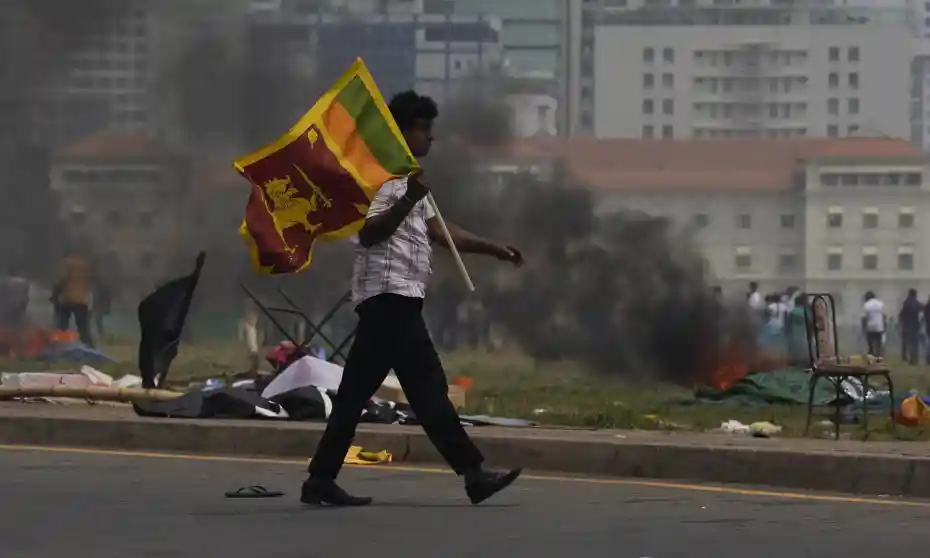
Sri Lankan Crisis and India
Sri Lanka has been going through very serious economic problems for some time now. Sri Lankan government is seemingly clueless about how to deal with this crisis, which is believed to be first of its kind for the country. There is no consensus in the government about how to deal with this situation.
Sri Lanka had come out of a very painful civil war in the past, which continued for 26 years and ended only in 2009. But despite the severity of the civil war at that time, Sri Lanka did not experience any big economic crisis. The rampant inflation in food and fuel in Sri Lanka, after January this year followed by acute shortage of goods is making life hell for the people of Sri Lanka.
Sri Lanka's per capita income in the year 2020 on the basis of market exchange rate was recorded at $4053 annually and on the basis of purchasing power parity, it was $12537 annually, which was more than double of that of India. If we talk about human development, according to the Human Development Report of the United Nations (2020), Sri Lanka ranked at 72nd position in the world, whereas India was at 131st position.
Sri Lanka's credit rating has been significantly lowered by international agencies, pushing Sri Lanka out of the international capital market. As a result, Sri Lanka could not reschedule its foreign borrowings. The devaluation of Sri Lanka's currency started due to the paucity of foreign exchange, and when Sri Lanka tried to curb imports, it led to shortage of commodities, especially fuel and food, causing hyperinflation. The Sri Lankan government believed that by curbing imports, foreign exchange would be saved and domestic production would be encouraged, which would also increase exports. But this could not happen and the foreign exchange reserves kept depleting further. The Sri Lankan government had to sell its gold reserves and enter into currency swap agreements with India and China to prevent any default in repayment of international debt.
Behind Sri Lanka's crisis is China's old strategy of debt trap. Not only Sri Lanka, but many more countries of the world have been trapped by China. Story starts with Sri Lanka accepting China’s proposal for development of Hambantota port, without any feasibility study. Between 2007 and 2014, China gave five loans amounting to $1.26 billion for the development of this port, in the beginning at 1 per cent or 2 per cent, but later escalated to 6.3 per cent with short repayment periods. After that China invested $1.4 billion in Columbo port city project. Billions of dollars in loans have been given to Sri Lanka by China, for developing a seaport, airport, highways and power stations. By 2020, Sri Lanka’s total liability to China had increased to about $ 8 billion (2020), but these projects are far from earning adequate revenues for debt servicing, even today.
Sri Lanka suddenly decided to move towards completely organic farming, in a very irresponsible manner and chemical fertilizers were banned. Due to the ban on the import of chemical fertilizers, agricultural production was affected badly and the prices of agricultural commodities started increasing wildly. Due to this the export of tea also got affected significantly. Although there is no harm in organic farming, but doing the same in an unmindful manner is no good.
While government revenues were already declining, the Sri Lankan government's reckless reduction in direct and indirect taxes made matters even worse. Due to compulsion to increase government spending, the budget deficit widened; leading to inevitable increase in money supply, and therefore inflation.
Sri Lanka has been importing a lot of essential goods for consumption; and when imports were banned, naturally there was a shortage of food and fuel. Sri Lanka's exporting industries were also affected due to non-availability of imported raw materials and essential intermediates. Due to which Sri Lanka's exports decreased significantly. China has provided billions of dollars in loans to Sri Lanka for developing a seaport, airport, highways and power stations. While the country’s debt liability to China has increased to about $ 8 billion (2020), these projects have yet to yield adequate revenues for debt servicing.
Significantly, Sri Lanka is home to a large number of Tamil people, who migrated from Tamil Nadu centuries ago. In view of the deteriorating situation in Sri Lanka, a large number of Tamil refugees are reaching the Tamil Nadu coast. Naturally, humanitarian help to them will be the priority of the Government of India and State government of Tamil Nadu. Apart from this, the government has given a credit line of $ 1 billion to Sri Lanka and has also given assistance of $ 500 million to buy essential petroleum products. Apart from this, the Sri Lankan government has sought additional assistance of $ 1.5 billion from the Indian government.
At the global level, the international organizations will have to come united and respond to this ill-fated effort of China. In addition, the Government of India may provide humanitarian and commercial assistance to Sri Lanka, and help them with an action plan for Sri Lanka's sustainable development. For this, the revival of Sri Lanka's agriculture, apart from rescheduling of debt and repayment of the sovereign debt; help in ending instability caused by the lack of raw materials in industries, ensure availability of essential commodities for the common people; are some other contours of India’s help to Sri Lanka. These endeavours can help India earning goodwill of Sri Lankan people; trapped in the clutches of China, and take it on the path of development once again. Today, when China's ill-fated strategy has been fully exposed, this is an important opportunity to defeat its Ill designs to disturb peace in Indian Ocean and remove its shadow from the region.


